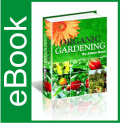A clever new way to use companion planting in your organic garden
A clever new way to use companion planting in your organic garden
Article by Dr John Yeoman
Can companion planting work in our organic gardens – to repel pests and diseases and grow more vegetables without chemicals? It depends upon our individual soil, light, weather and many other factors.
A tip that may work for one gardener – like growing aromatic plants around cabbages to repel flying pests – may work in one garden. But other growers might find they have to sow those companion plants so thickly around the cabbages to deter pests that they depress the growth of the cabbages.
So how do you know if a specific companion plant or method of companion planting will work in your garden?
Simply, grow the companion plants in pots! Then you can move the pots around your beds to test if a particular plant deters flying pests or not – and, if so, how many plants you need. Using pots, you can even take the perennial plants indoors in winter.
Aromatic herbs work well as companion plants in pots
This method works well with aromatic herbs like borage, which – in some gardens – have been known to keep cabbage white butterflies off brassica. It might work even with parsley, onions or chives which are said, if very thickly set around carrots, to repel carrot root fly.
But, of course, the method is effective only against flying pests. For example, the pungent flowers of Tagetes minuta (Mexican marigold) deter whitefly, aphids and cabbage white butterflies but the plant is far more useful for its root secretions. These are said to suppress nematodes, couch grass, creeping elder and bindweed by working in the soil itself.
Nor are companion plants in pots likely to help peas and beans to attract pollinating bees. Research suggests that bees focus on just one type of pollen-rich plant at a time and, once they find it, the hive will not be distracted by other plants. This will be a blow to those gardeners who hopefully intertwine their climbing beans with nasturtiums and sweet peas. Beauty may be guaranteed but not, it seems, bean set.
A clever way to test companion planting as a pest repellent
Companion planting in the conventional way is hit-or-miss as a pest repellent but you can still test some plant combinations very precisely – using essential oils. For example, soak the leaves and flowers of Tagetes – a fabled pest repellant – in alcohol for a week or two. (A ready source of cheap, undrinkable alcohol is own-label supermarket vodka.)
Then spray this infusion, diluted in water in a 1:20 ratio, or at whatever strength is apt to your pest problem, directly onto any plant that’s at risk from flying insects. Spraying plants also overcomes the problem of growing, in an annual crop rotation, perennial companion plants which stay in their place for several years.
You can see for yourself
Using this method of ‘companion planting’, you can see for yourself what works in your garden – and what doesn’t. For example, the UK’s Southampton University found that extracts of hyssop, rosemary, sage, thyme or white clover, sprayed on cabbages, did help protect them from diamondback moths and white cabbage butterflies.
Yet the same companion plants grown beside the cabbages in pots had no effect. The companions themselves emitted too little repellent odour unless they were crushed.
Another idea, even simpler, is to soak non-degradable cloths in the essential oils and prop them around the plants you want to protect. (Old nylon socks and balled pantihose, even pads of fibreglass roof insulation, work well.) The downside to this method is, you have to renew the pads every few days. (The upside is that such pads, soaked in hot chilli sauce, are a very effective humane repellent for cats.)
You could test the pot method using any aromatic oil derived from a companion herb or spicy plant. Why not try sage against carrot fly, or rosemary against bean beetle, or garlic oil against everything? Try whatever combination you wish. Just take the plants’ essential oils where they are needed, when they’re needed!
For a free big 6000-word ebook Lazy Secrets for Natural Gardening Success, go to: http://www.gardeningguild.org/lazy
About the Author
Dr John Yeoman PhD is founder of the centre for natural gardening ideas, the Gardening Guild.

 September 28, 2011
September 28, 2011 








Trackbacks/Pingbacks
[…] #split {}#single {}#splitalign {margin-left: auto; margin-right: auto;}#singlealign {margin-left: auto; margin-right: auto;}.linkboxtext {line-height: 1.4em;}.linkboxcontainer {padding: 7px 7px 7px 7px;background-color:#eeeeee;border-color:#000000;border-width:0px; border-style:solid;}.linkboxdisplay {padding: 7px 7px 7px 7px;}.linkboxdisplay td {text-align: center;}.linkboxdisplay a:link {text-decoration: none;}.linkboxdisplay a:hover {text-decoration: underline;} function opensplitdropdown() { document.getElementById('splittablelinks').style.display = ''; document.getElementById('splitmouse').style.display = 'none'; var titleincell = document.getElementById('titleincell').value; if (titleincell == 'yes') {document.getElementById('splittitletext').style.display = 'none';} } function closesplitdropdown() { document.getElementById('splittablelinks').style.display = 'none'; document.getElementById('splitmouse').style.display = ''; var titleincell = document.getElementById('titleincell').value; if (titleincell == 'yes') {document.getElementById('splittitletext').style.display = '';} } How to Create & Manage an Organic Garden : Starting an Indoor Organic GardenFood4Wealth – Discover How To Cultivate Your Own Organic CropsAquaponics – What is it & Can It Work For You?Backyard Aquaponics SystemWhy Vegetable Rotation is Key for Organic GardeningHow To Begin Organic GardeningWhy Worm Castings Are Essential in Organic GardeningOrganic Gardening Secret To Attract Birds – Your Organic Gardening BlogOrganic gardening and natural pest managementA clever new way to use companion planting in your organic garden […]